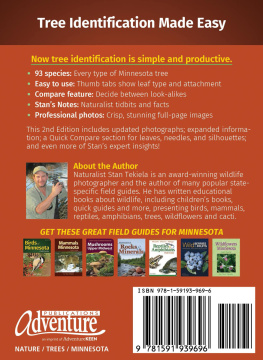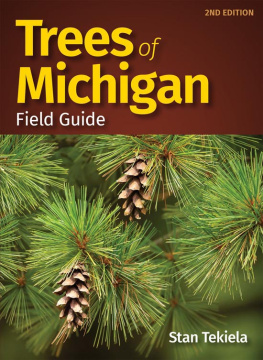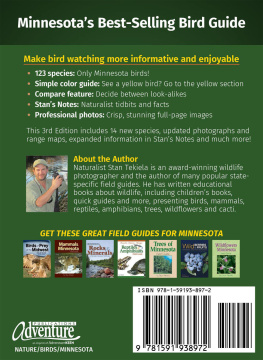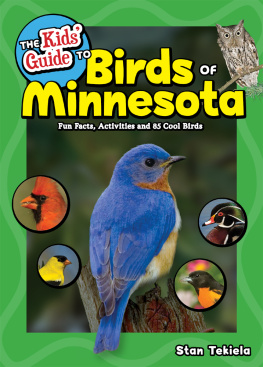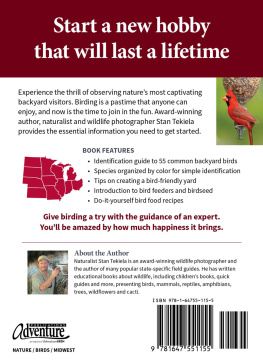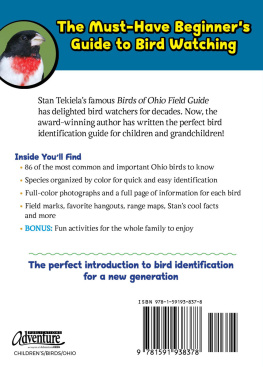
Edited by Sandy Livoti and Dan Downing
Cover, book design and illustrations by Jonathan Norberg
Range maps produced by Anthony Hertzel
Cover photo: Baltimore Oriole by Stan Tekiela; background by Gestalt Imagery/Shutterstock
All photos by Stan Tekiela except (female) by Jim Zipp
To the best of the publishers knowledge, all photos were of live birds. Some were photographed in a controlled condition.
10 9 8 7 6 5 4 3 2 1
Birds of the Dakotas Field Guide
First Edition 2003
Second Edition 2022
Copyright 2003 and 2022 by Stan Tekiela
Published by Adventure Publications
An imprint of AdventureKEEN
310 Garfield Street South
Cambridge, Minnesota 55008
(800) 678-7006
www.adventurepublications.net
All rights reserved
Printed in the United States of America
ISBN 978-1-64755-192-6 (pbk.); ISBN 978-1-64755-193-3 (ebook)
TABLE OF CONTENTS
WHATS NEW?
It is hard to believe that its been more than 15 years since the debut of Birds of the Dakotas Field Guide. This critically acclaimed field guide has helped countless people identify and enjoy the birds that we love. Now, in this expanded second edition, Birds of the Dakotas Field Guide has many new and exciting changes and a fresh look, while retaining the same familiar, easy-to-use format.
To help you identify even more birds in the Dakotas, I have added 8 new species and more than 150 new color photographs. All of the range maps have been meticulously reviewed, and many updates have been made to reflect the ever-changing movements of the birds.
Everyones favorite section, Stans Notes, has been expanded to include even more natural history information. Compare sections have been updated to help ensure that you correctly identify your bird, and additional feeder information has been added to help with bird feeding. I hope you will enjoy this great new edition as you continue to learn about and appreciate our North and South Dakota birds!

WHY WATCH BIRDS IN THE DAKOTAS?
Millions of people have discovered bird feeding. Its a simple and enjoyable way to bring the beauty of birds closer to your home. Watching birds at your feeder often leads to a lifetime pursuit of bird identification. The Birds of the Dakotas Field Guide is for those who want to identify common birds of North Dakota and South Dakota.
There are over 1,100 species of birds found in North America. In North and South Dakota there have been more than 400 different kinds of birds recorded through the years. These bird sightings were diligently recorded by hundreds of bird watchers and became part of the official state record. From these valuable records, Ive chosen 133 of the most common birds of North and South Dakota to include in this field guide.
Bird watching, or birding, is one of the most popular activities in America. Its outstanding appeal in the Dakotas is due, in part, to an unusually rich and abundant birdlife. Why are there so many birds? One reason is open space. North Dakota is over 70,700 square miles (183,800 sq. km) and is the eighteenth-largest state. South Dakota is even larger, covering more than 77,100 square miles (200,400 sq. km), and is the seventeenth-largest state. Combined, these states make up a large portion of the North Central region and provide the majority of nesting habitats for a large number of birds, especially waterfowl, in this area of the U.S.
Vast open spaces in the Dakotas are not the only reason there is such an abundance of birds. Its also the diversity of habitat. The Dakotas can be broken into two distinct regions, each of which supports a different group of birds.
The highest and driest part of the Dakotas is in the western half. Called the Great Plains, this region has major features that are quite unlike its wide-open plains. The Black Hills and Badlands are highly unique jewels and wonderful places to see birds such as Western Tanagers and Lazuli Buntings. The rest of the region is a relatively flat, open space that was once short grass prairie, but is now mostly agricultural. Horned Larks, Lark Buntings, Western Kingbirds and many other open-country birds can be found here.
The eastern half of the Dakotas is exemplified by the wide, flat, former lake bottom known as Glacial Lake Agassiz. This region, with its many temporary ponds and lakes, is much wetter than its western counterpart. These habitats provide very important breeding grounds for waterfowl such as Gadwalls and Mallards.
Not only do the Dakotas have varying habitats, there are variations in the weather. Since the two states extend over 450 miles (725 km) from north to south, the weather ranges greatly. While summers can be extremely hot and steamy, the high winds and driving snows of winter are legendary.
No matter where you are in the Dakotas there are birds to watch in every season. Whether witnessing a migration of millions of waterfowl in autumn or welcoming back shorebirds in spring, there is variety and excitement in birding as each season turns to the next.
OBSERVE WITH A STRATEGY: TIPS FOR IDENTIFYING BIRDS
Identifying birds isnt as difficult as you might think. By simply following a few basic strategies, you can increase your chances of successfully identifying most birds that you see. One of the first and easiest things to do when you see a new bird is to note its color. This field guide is organized by color, so simply turn to the right color section to find it.
Next, note the size of the bird. A strategy to quickly estimate size is to compare different birds. Pick a small, a medium and a large bird. Select an American Robin as the medium bird. Measured from bill tip to tail tip, a robin is 10 inches (25 cm). Now select two other birds, one smaller and one larger. Good choices are a House Sparrow, at about 6 inches (15 cm), and an American Crow, around 18 inches (45 cm). When you see a species you dont know, you can now quickly ask yourself, Is it larger than a sparrow but smaller than a robin? When you look in your field guide to identify your bird, you would check the species that are roughly 610 inches (1525 cm). This will help to narrow your choices.
Next, note the size, shape and color of the bill. Is it long or short, thick or thin, pointed or blunt, curved or straight? Seed-eating birds, such as Northern Cardinals, have bills that are thick and strong enough to crack even the toughest seeds. Birds that sip nectar, such as Ruby-throated Hummingbirds, need long, thin bills to reach deep into flowers. Hawks and owls tear their prey with very sharp, curving bills. Sometimes, just noting the bill shape can help you decide whether the bird is a woodpecker, finch, grosbeak, blackbird or bird of prey.
Next, take a look around and note the habitat in which you see the bird. Is it wading in a saltwater marsh? Walking along a riverbank or on the beach? Soaring in the sky? Is it perched high in the trees or hopping along the forest floor? Because of diet and habitat preferences, youll often see robins hopping on the ground but not usually eating seeds at a feeder. Or youll see a Blue Jay sitting on a tree branch but not climbing headfirst down the trunk, like a Red-breasted Nuthatch would.
Noticing what the bird is eating will give you another clue to help you identify the species. Feeding is a big part of any birds life. Fully one-third of all bird activity revolves around searching for food, catching prey and eating. While birds dont always follow all the rules of their diet, you can make some general assumptions. Northern Flickers, for instance, feed on ants and other insects, so you wouldnt expect to see them visiting a seed feeder. Other birds, such as Barn and Cliff Swallows, eat flying insects and spend hours swooping and diving to catch a meal.
Next page



